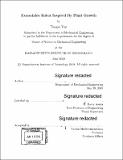| dc.contributor.advisor | H. Harry Asada. | en_US |
| dc.contributor.author | Yan, Tongxi,S.M.Massachusetts Institute of Technology. | en_US |
| dc.contributor.other | Massachusetts Institute of Technology. Department of Mechanical Engineering. | en_US |
| dc.date.accessioned | 2019-12-13T18:53:49Z | |
| dc.date.available | 2019-12-13T18:53:49Z | |
| dc.date.copyright | 2019 | en_US |
| dc.date.issued | 2019 | en_US |
| dc.identifier.uri | https://hdl.handle.net/1721.1/123241 | |
| dc.description | Thesis: S.M., Massachusetts Institute of Technology, Department of Mechanical Engineering, 2019 | en_US |
| dc.description | Cataloged from PDF version of thesis. | en_US |
| dc.description | Includes bibliographical references (page 47). | en_US |
| dc.description.abstract | A novel design of extendable robotic arm inspired by plant growth is presented. The robot can construct its own body structure by converting a type of fluidized material into a rigid structure at its growing point. It extends its structure in multiple directions, and move through a winding space to reach a point, which is otherwise difficult to access. The robot with the rigid structure can also bear a more significant load than existing growing robot, has a plate to attach an end-effector, and can transport an object. The robot satisfies three key functional requirements that are characteristic to plant growth. First, the robot is capable of transporting structural materials to its growing point. Second, the robot is capable of transforming the material into a rigid structure. Third, it is capable of steering its growing point so that it extends in a desired direction. A proof-of-concept prototype is then presented that consists of a customized chain that can be switched between fluidized and rigid states, a winch that can transport the chain, and a steering system to direct the growing direction. The prototype meets all the functional requirements by moving along a path and retract to the starting position. What follows this prototype is the second design that solves some issues found in the first design. Details of major changes from the initial design are presented and is validated in a virtual environment. | en_US |
| dc.description.statementofresponsibility | by Tongxi Yan. | en_US |
| dc.format.extent | 47 pages | en_US |
| dc.language.iso | eng | en_US |
| dc.publisher | Massachusetts Institute of Technology | en_US |
| dc.rights | MIT theses are protected by copyright. They may be viewed, downloaded, or printed from this source but further reproduction or distribution in any format is prohibited without written permission. | en_US |
| dc.rights.uri | http://dspace.mit.edu/handle/1721.1/7582 | en_US |
| dc.subject | Mechanical Engineering. | en_US |
| dc.title | Extendable robot inspired By plant growth | en_US |
| dc.type | Thesis | en_US |
| dc.description.degree | S.M. | en_US |
| dc.contributor.department | Massachusetts Institute of Technology. Department of Mechanical Engineering | en_US |
| dc.identifier.oclc | 1130059217 | en_US |
| dc.description.collection | S.M. Massachusetts Institute of Technology, Department of Mechanical Engineering | en_US |
| dspace.imported | 2019-12-13T18:53:48Z | en_US |
| mit.thesis.degree | Master | en_US |
| mit.thesis.department | MechE | en_US |
